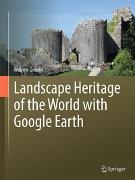Mehr lesen
The rationale of this book is to provide carefully selected images from Google Earth, to discuss what they show, and to provide references to the heritage sites portrayed so that readers can go deeper if they wish. Taking examples from all over the world, this book aims to demonstrate their value for understanding heritage landscapes and for appreciating their aesthetics. It is organised around different types of landscape and the processes that created them, rather than regionally or on the basis of age. It includes a large number of archaeological sites that have been designated as UNESC0 World Heritage Sites. Google Earth has proved to be important for demonstrating some of the threats that major sites have been exposed to, including during recent wars in the Middle East. The landscapes discussed are those of Water Management, Agricultural Management, War, Burial, Mines, Quarries and Salterns, Cities and Settlements, Tells, Theatres, Amphitheatres, and Hippodromes, Churches, Temples, Pagodas, and Mosques, and Geoglyphs.
Inhaltsverzeichnis
Chapter 1. Introduction.- Chapter 2. Landscapes of Water Management.- Chapter 3. Landscapes of Agricultural Management.- Chapter 4. Defences.- Chapter 5. Burial Sites.- Chapter 6. Mines, Quarries and Salterns.- Chapter 7. Cities and Settlements.- Chapter 8. Tells.- Chapter 9. Theatres, Amphitheatres, and Hippodromes.- Chapter 10. Churches, Temples, Pagodas, Mosques.- Chapter 11. Geoglyphs.
Über den Autor / die Autorin
Andrew Goudie, PhD, DSc, Emeritus Professor of Geography at the University of Oxford, former Pro-Vice-Chancellor, former Director of the China Centre, Honorary Fellow of Hertford College and the former Master of St Cross College, is a geomorphologist. He is a recipient of a Royal Medal from the Royal Geographical Society, the Mungo Park Medal of the Royal Scottish Geographical Society, and the Farouk El-Baz Award of the Geological Society of America. He is a Fellow of the British Society of Geomorphologists. He has been Chair of the British Geomorphological Research Group, President of the Geographical Association, and President of the International Association of Geomorphologists. He has written extensively on geomorphology in some fifty books and 300 scientific papers. He is the author of among others The Landforms of England and Wales (1990), Great Warm Deserts of the World (2002), Arid and Semi-arid Geomorphology (2012), Great Desert Explorers (2016), TheHuman Impact (2018), Landscapes and Landforms of England and Wales (with Piotr Migoń) (2020), Camel Tracks (2021), and (with Denys Brunsden), Geological Pioneers of the Jurassic Coast (2023). Recently he has used Google Earth in three companion volumes: Desert Landscapes of the World with Google Earth (2022), Landscapes of the Anthropocene with Google Earth (2023), and Rocky Landscapes of the World with Google Earth(2024).
Zusammenfassung
The rationale of this book is to provide carefully selected images from Google Earth, to discuss what they show, and to provide references to the heritage sites portrayed so that readers can go deeper if they wish. Taking examples from all over the world, this book aims to demonstrate their value for understanding heritage landscapes and for appreciating their aesthetics. It is organised around different types of landscape and the processes that created them, rather than regionally or on the basis of age. It includes a large number of archaeological sites that have been designated as UNESC0 World Heritage Sites. Google Earth has proved to be important for demonstrating some of the threats that major sites have been exposed to, including during recent wars in the Middle East. The landscapes discussed are those of Water Management, Agricultural Management, War, Burial, Mines, Quarries and Salterns, Cities and Settlements, Tells, Theatres, Amphitheatres, and Hippodromes, Churches, Temples, Pagodas, and Mosques, and Geoglyphs.

